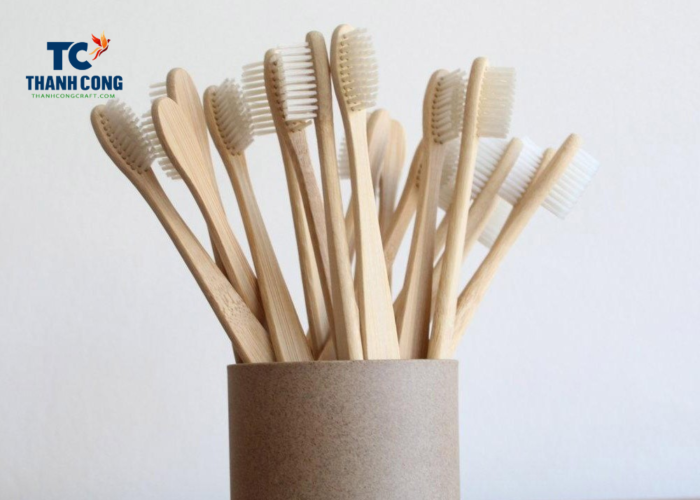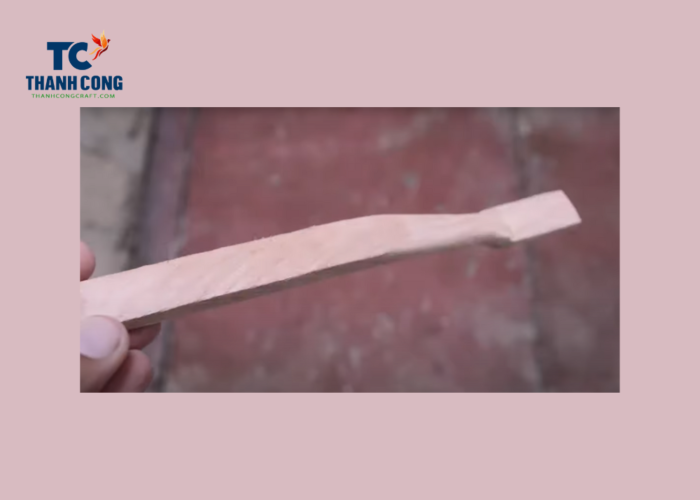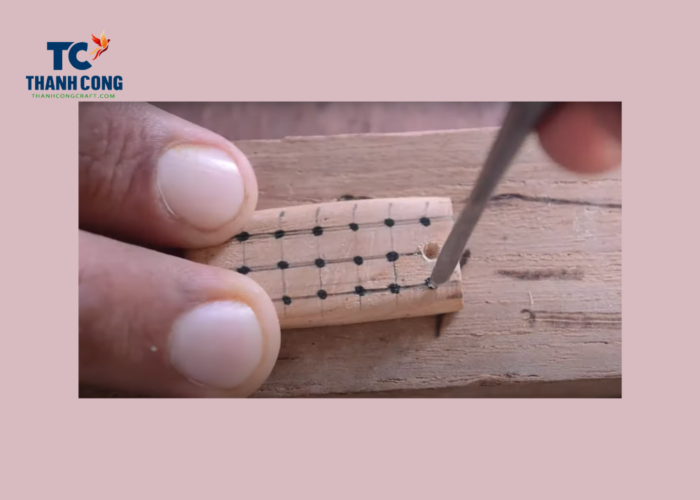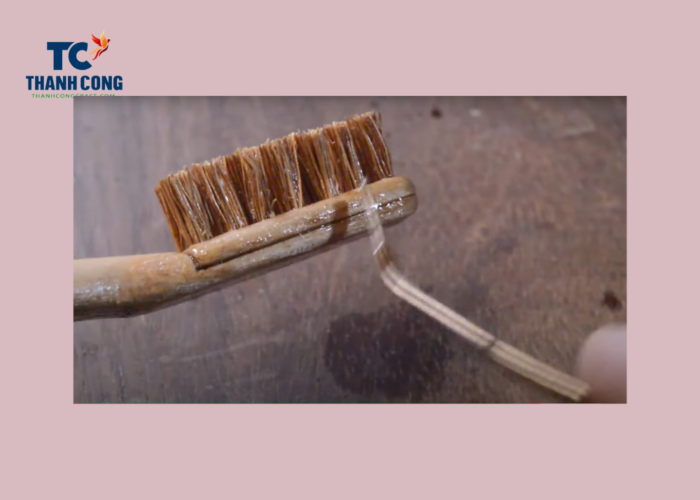Bamboo is a type of soft, durable and eco-friendly plant that can be used to make many different products, including toothbrushes. Did you know that you can make your own bamboo toothbrush at home? In this article, we will guide you how to make bamboo toothbrush at home from simple and safe ingredients. Let’s follow along!
Contents [hide]
1. What materials are used to make a bamboo toothbrush?
Bamboo toothbrush is an environmentally friendly product made from natural and renewable materials. Here are the key materials typically used in crafting a bamboo toothbrush:
Bamboo Handle: Bamboo is the primary material for the handle of a bamboo toothbrush. It is chosen for its rapid growth, renewability, and biodegradability. Bamboo is an environmentally friendly alternative to plastic, which is a major contributor to pollution.

Bristles: Biodegradable Material: The bristles of a bamboo toothbrush are often made from plant-based materials such as castor bean oil or nylon-4, which is more biodegradable than traditional nylon. However, finding fully biodegradable bristles can be a challenge, and some bamboo toothbrushes still use traditional nylon bristles.
Adhesive: Natural Glue: The adhesive used to attach the bristles to the bamboo handle is usually a natural and non-toxic glue. This helps maintain the eco-friendly nature of the toothbrush.
Packaging: Minimalist Packaging: To further reduce environmental impact, bamboo toothbrushes often come in minimalistic and eco-friendly packaging. Some brands use recycled cardboard or paper that can be easily recycled or composted.
Dyes or Inks: Natural Coloring: If the toothbrush features any coloring, the dyes or inks used are typically natural and safe for the environment. This ensures that no harmful chemicals are introduced during the manufacturing process.
Sealers or Coatings: Natural Sealers: In some cases, bamboo toothbrushes may have a natural sealer or coating applied to protect the bamboo from water and use. These sealers are usually non-toxic and biodegradable. Some bamboo toothbrushes also come with a layer of beeswax or coconut oil coating to enhance water resistance and prolong longevity.
2. How to make bamboo toothbrush at home?
Bamboo toothbrushes are an environmentally friendly product, helping to reduce plastic waste and protect oral health. You can make your own bamboo toothbrush at home with simple and easy-to-find materials.
Here are the steps to make a bamboo toothbrush:
Step 1: Prepare the materials
You will need a bamboo stick about 15-20 cm long, a sharp knife, a small drill, a box of bamboo or cotton fibers, and a box of glue.
Step 2: Create the handle
Cut the bamboo stick into a short section about 10-12 cm, then peel off the skin and split the ends of the bamboo stick to create two grooves. You can use a sharp knife or scissors to do this. You should choose a bamboo stick with a diameter that fits your hand and has a moderate hardness.

Step 3: Create holes for the bristles
Use a small drill to drill small holes on the flat surface of the bamboo stick, spaced about 2-3 mm apart. You should drill from 15-20 holes, depending on the size of the bamboo stick and the thickness of the bristles.
You should also drill deep about 3-4 mm to make the bristles more secure.

Step 4: Insert the bristles into the holes
Cut the bamboo or cotton fibers into short sections about 2-3 cm, then tear each section into thinner strands. Use a wooden stick or needle to insert each strand into each hole on the bamboo stick, so that the strand fills the hole and does not fall out.
You should insert from 3-5 strands into each hole, depending on the softness of the strand and the width of the hole.

Step 5: Glue the bristles
Use glue to apply to the grooves on both ends of the bamboo stick, then fold them together to clamp the bristles in between. You should use glue that is water-resistant and does not harm your health. Let the glue dry for 24 hours before using.

3. FAQs
3.1 Is bamboo better than normal toothbrush?
Yes, bamboo toothbrushes are considered superior to conventional plastic toothbrushes for several compelling reasons. Firstly, bamboo toothbrushes are environmentally friendly as they are made from a renewable resource that grows quickly.
- The biodegradability of bamboo makes it a sustainable option, breaking down naturally and reducing the long-lasting.
- By choosing bamboo, individuals actively contribute to the reduction of plastic waste, a critical environmental concern.
- In summary, the sustainability, biodegradability, and overall lower environmental impact make bamboo toothbrushes a preferable choice over traditional plastic alternatives.
3.2 What are the bristles on a bamboo toothbrush made of?
The bristles on a bamboo toothbrush can be made from various materials, depending on the brand and product. Commonly, they are crafted from plant-based materials such as castor bean oil or nylon-4, which is a more biodegradable form of nylon.
However, it’s crucial to note that finding fully biodegradable bristles can be challenging, and some bamboo toothbrushes may still incorporate traditional nylon bristles.
It’s recommended to check the product details and specifications provided by the manufacturer to ensure that the bristles align with your sustainability preferences. Some brands are making efforts to offer eco-friendly bristle options to enhance the overall environmental friendliness of bamboo toothbrushes.
3.3 Why do bamboo toothbrushes have nylon bristles?
Bamboo toothbrushes are a popular choice for people who want to reduce their environmental impact and use natural materials. However, many bamboo toothbrushes still have nylon bristles, which are synthetic and not biodegradable. Why is that?
One reason is that nylon bristles are more effective and durable than natural alternatives, such as animal hair or plant fibers. Nylon bristles can clean the teeth and gums better, resist bacteria growth, and last longer. Natural bristles may also cause allergic reactions, shed easily, or be too hard or soft for the teeth.
Another reason is that there are not many options for natural bristles that are compatible with bamboo handles. Bamboo is a very hard and dense material, which requires a special drilling process to insert the bristles. Nylon bristles can be attached to bamboo handles using heat or glue, but natural bristles may not adhere well or may damage the bamboo.
Therefore, bamboo toothbrushes have nylon bristles because they offer better performance, durability, and compatibility than natural bristles. However, some bamboo toothbrushes have biodegradable nylon bristles, which can be composted or recycled after use. This can help reduce the environmental impact of bamboo toothbrushes and make them more eco-friendly.
3.4 How long does a bamboo toothbrush last?
A bamboo toothbrush can last from 3 to 6 months, depending on how you use and store it. You should replace your toothbrush when the bristles are worn or bent, or when you feel it is no longer effective in cleaning your teeth.
To extend the lifespan of your bamboo toothbrush, you should keep it dry after each use, avoid leaving it in a damp or wet place, or in contact with water continuously. You should also choose a toothbrush with bristles made from natural or biodegradable fibers, to reduce plastic waste.
3.5 How do you sterilize a bamboo toothbrush?
Sterilizing a bamboo toothbrush is a simple process. Here are a few methods you can use:
- Boiling Water: Bring a pot of water to a boil. Submerge the bamboo toothbrush in the boiling water for about 2-3 minutes. Remove the toothbrush and let it air-dry completely before using.
- Vinegar Soak: Create a mixture of equal parts water and white vinegar in a cup. Soak the toothbrush in the vinegar solution for 15-20 minutes. Rinse the toothbrush with water and let it air-dry.
- Antiseptic Mouthwash Rinse: Pour a small amount of antiseptic mouthwash into a cup. Swirl the toothbrush head in the mouthwash for about 1-2 minutes. Rinse the toothbrush thoroughly with water and let it air-dry.
- UV Sanitizer: If available, you can use a UV sanitizer designed for toothbrushes. Place the bamboo toothbrush in the sanitizer following the manufacturer’s instructions.
If you have any further questions, don’t hesitate to send thanhcongcraft an email us at info@thanhcongcraft.com or message us at WhatsApp: +84967485411. Hope to serve you soon! Best regard!


